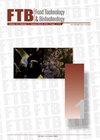普托瑞辛通过调节 B16F1 小鼠黑色素瘤细胞中的 MITF 转录因子上调黑色素生成
IF 2.5
4区 农林科学
Q3 BIOTECHNOLOGY & APPLIED MICROBIOLOGY
引用次数: 0
摘要
研究背景。衰老是一种生化、代谢和遗传生理现象。由于翻译失败、酶活性降低和细胞衰老,黑色素的生物合成受到抑制,表现为头发变白,这是衰老的一个标志。普托瑞辛是多胺家族中最小的成员,也是一种有机化学物质,存在于哺乳动物的活细胞中,在调节皮肤黑色素生成方面起着至关重要的作用。因此,本研究的目的是探讨腐胺对黑色素瘤细胞黑色素生成信号通路的影响。实验方法:通过酪氨酸酶活性检测法研究普瑞巴林对黑色素生成能力的影响。为了评估暴露于石碱的 B16F1 细胞的活力,进行了 MTT 试验。在 H2O2 存在的情况下,使用各种体外试验评估了腐胺对 B16F1 细胞黑色素合成的影响。通过专用的黑色素生成试验,评估了腐胺对 B16F1 细胞黑色素生成的影响。基因表达分析是通过 RT-PCR 技术进行的。此外,还通过免疫荧光和 Western 印迹分析研究了腐胺对 H2O2 处理细胞中黑色素生成相关蛋白表达的影响。结果和结论苦参碱提高了 B16F1 细胞中酪氨酸酶的活性,并显示出无毒性。此外,从 DCFH-DA 分析中细胞内 H2O2 水平的降低可以看出,腐胺能有效清除 H2O2,并促进活细胞中黑色素的生成。腐霉利刺激黑色素生成的原因是 Mitf、Tyr、Trp-1 和 Trp-2 基因的表达升高。免疫荧光研究发现,腐霉利能增强黑色素生成相关蛋白的表达,通过MITF转录因子上调TYR、TRP-1和TRP-2,并增加H2O2处理细胞中MSRA和MSRB的表达,从而有效促进黑色素生成。这些研究结果表明,可利用腐胺刺激黑色素的合成。石灰华可单独用作化妆品,防止头发过早变白。本文章由计算机程序翻译,如有差异,请以英文原文为准。
Putrescine Upregulates Melanogenesis Through Modulation of MITF Transcription Factor in B16F1 Mouse Melanoma Cells
Research background. Aging is a biochemical, metabolic, and genetic physiological phenomenon. The suppression of melanin biosynthesis, evident in the graying of hair, is a hallmark of aging resulting from translation failure, reduced enzyme activity, and cellular senescence. Putrescine, the smallest member of the polyamine family and an organic chemical, is present in living mammalian cells, playing a crucial role in regulating skin melanogenesis. Therefore, the purpose of this study is to explore the effect of putrescine on the signaling pathways of melanogenesis in melanoma cells.
Experimental approach. Putrescine was studied on the melanin production capacity was examined through a tyrosinase activity assay. To assess the cell viability of B16F1 cells exposed to putrescine, an MTT assay was performed. The impact of putrescine on melanin synthesis in the presence of H2O2 was evaluated using various in vitro assays in B16F1 cells. The effect of putrescine on melanin production in B16F1 cells was achieved through a dedicated melanin production assay. Gene expression analysis was conducted using RT-PCR. Furthermore, the impact of putrescine on the expression of proteins related to melanin production in H2O2-treated cells was examined through immunofluorescence and western blot analysis.
Results and conclusions. Putrescine increased tyrosinase activity and demonstrated non-cytotoxicity in B16F1 cells. Furthermore, putrescine effectively scavenged H2O2, as evidenced by the reduction in intracellular H2O2 levels in DCFH-DA analysis, and promoted melanin production in living cells. The stimulation of melanogenesis by putrescine was attributed to the elevated expression of Mitf, Tyr, Trp-1, and Trp-2 genes. Immunofluorescence investigations revealed that putrescine enhanced the expression of proteins associated with melanogenesis and upregulated TYR, TRP-1, and TRP-2 via the MITF transcription factor and increased the expression of MSRA and MSRB in H2O2-treated cells, thereby effectively promoting melanogenesis. These findings suggest that putrescine may be utilized to stimulate melanin synthesis.
Novelty and scientific contribution. Putrescine could be solely used as a cosmetic agent to prevent premature graying of hair.
求助全文
通过发布文献求助,成功后即可免费获取论文全文。
去求助
来源期刊

Food Technology and Biotechnology
工程技术-生物工程与应用微生物
CiteScore
3.70
自引率
0.00%
发文量
33
审稿时长
12 months
期刊介绍:
Food Technology and Biotechnology (FTB) is a diamond open access, peer-reviewed international quarterly scientific journal that publishes papers covering a wide range of topics, including molecular biology, genetic engineering, biochemistry, microbiology, biochemical engineering and biotechnological processing, food science, analysis of food ingredients and final products, food processing and technology, oenology and waste treatment.
The Journal is published by the University of Zagreb, Faculty of Food Technology and Biotechnology, Croatia. It is an official journal of Croatian Society of Biotechnology and Slovenian Microbiological Society, financed by the Croatian Ministry of Science and Education, and supported by the Croatian Academy of Sciences and Arts.
 求助内容:
求助内容: 应助结果提醒方式:
应助结果提醒方式:


